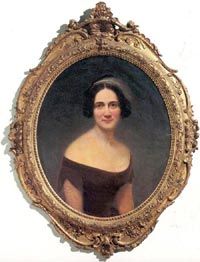(Mary Boykin Chesnut, portrait by Samuel Osgood,
1850s. On loan to
National Portrait Gallery, Smithsonian Institution,
by Serena VanRensselaer.)
Mary Boykin Chesnut
Widely recognized as one of the most astute observers of the events and
people of the Civil War, the diary of Mary Boykin Chesnut is generally the
first southern woman's voice consulted by historians in search of personal
descriptions of the war. A recognized expert on Chesnut, Dr. Muhlenfeld is
the author of Mary
Boykin Chesnut: A Biography and Two Novels
by Mary Chesnut.
Mary Boykin Miller Chesnut (1823-1886) is known today for her
brilliant, shocking and witty first-hand account of the rise and fall of
the Confederate States of America.
Censored versions of her diaries came out in 1905 and in 1949, under
the title, Diary from Dixie. In 1982, the journals were republished as
Mary Chesnut's Civil War. It is far more than a simple account of the war,
however, for Mary's drawing room was a salon for many of the most
prominent political and military figures in the Confederacy.
She was the daughter of a South Carolina governor and United States
senator. She was born in Statesburg and came from stock who had fought
bravely in the American Revolution. She was schooled at Madame Talvande's
on Lagare Street in Charleston, read voraciously and often went to the
theatre.

(Mary Boykin Chesnut and John Chesnut, Jr. about 1840,
the year of their marriage, from daguerrotype ca 1840. Courtesy of
Mulberry Plantation, Camden, South Carolina. )
At fourteen, she fell in love with James Chesnut, 23, son of a wealthy
landowner. After a tumultuous courtship, they were married when Mary was
17. In 1858 James and Mary (now 35) went to Washington for him to serve as
a U.S. senator.
During the war, James served as an aide to Beauregard and Jefferson
Davis and later became a general. James was the officer who had the
dubious duty of calling the first shot in the war on Fort Sumter at the
order of President Davis. Mary was childless, which allowed her to follow
her husband and the government of the Confederacy from Montgomery to
Richmond, as well as other stops along the way.
Mary Chesnut served as an unwitting investigative reporter of the most
important event of our country's history. Her eyewitness accounts,
motivated by her insatiable desire to understand and chronicle the society
of the entire war. Because of her particular genius, often referred to as
her incisive with, she not only gives us a historical journal, but a
deeply moving and wildly humorous account.
This, no doubt, is why A World Kicked to Pieces: Mary Boykin Chesnut on
Love & War by Kenneth Grahame is such is a successful play.
Mary Chesnut's last 20 years were extremely difficult for her. She
helped her family try to reestablish some order and security. She also had
a "butter and egg" business and ran a type of lending library in an
attempt to get ahold of as much reading material as possible.
It was also during this time she spent numerous years reworking her
diaries into her Civil War journal. This work in its greatest and most
uncensored form was not to see the light of day until Dr. C. Vann Woodward
did his brilliant and scholarly compilation in 1982, Mary Chesnut's Civil
War.
Thus, roughly 100 years after she had begun her final revisions on her
journal, she finally got her chance to tell her amazing tale. Graham's
play, completed in 1996, now gives audiences a chance to meet her face to
face.


